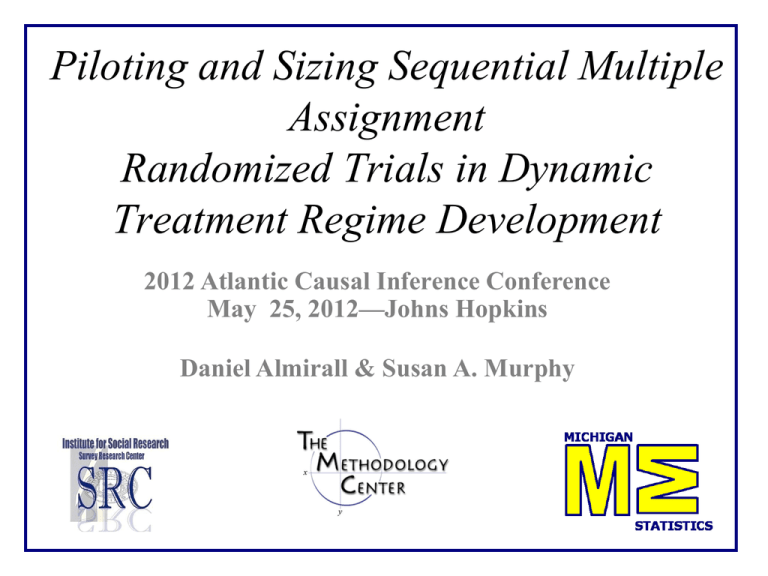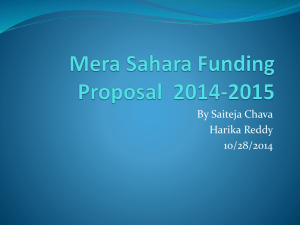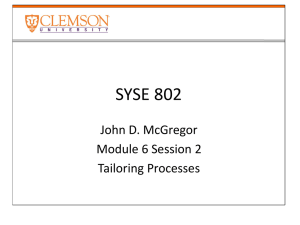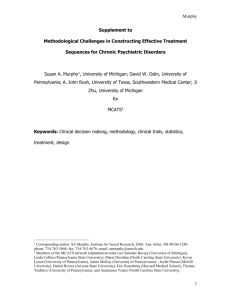ACIC_2012
advertisement

Piloting and Sizing Sequential Multiple Assignment Randomized Trials in Dynamic Treatment Regime Development 2012 Atlantic Causal Inference Conference May 25, 2012—Johns Hopkins Daniel Almirall & Susan A. Murphy Outline • Dynamic Treatment Regimes • Sequential Multiple Assignment Randomized Trial (SMART) • External Pilots – Tailoring Variables – Transition to Next Stage – Assessment Schedule – Sizing a Pilot SMART 2 Dynamic treatment regimes are individually tailored sequences of treatments, with treatment type and dosage changing according to patient outcomes. Operationalizes clinical practice. k Stages for one individual Patient data available at jth stage Action at jth stage (usually a treatment) 3 Dynamic Treatment Regimes • A dynamic treatment regime (DTR) is a sequence of decision rules, one per treatment stage. • Each decision rule inputs one or more tailoring variables and outputs a treatment action. • The tailoring variables are (summaries of) patient data available at each stage. 4 Example of a Dynamic Treatment Regime (DTR) •Adaptive Drug Court Program for drug abusing offenders. •Goal is to minimize recidivism and drug use. •Marlowe et al. (2008, 2009) 5 Adaptive Drug Court Program non-responsive low risk As-needed court hearings + standard counseling As-needed court hearings + ICM non-compliant high risk non-responsive Bi-weekly court hearings + standard counseling Bi-weekly court hearings + ICM non-compliant Court-determined disposition 6 Sequential, Multiple Assignment, Randomized Trial (SMART) At each stage subjects are randomized among alternative options. For k=2, data on each subject is of form: Aj is a randomized treatment action with known randomization probability. 7 •Usually the treatment options for A2 are restricted by the values of one or more summaries of (X1, A1, X2) • These summaries are embedded tailoring variables; they are embedded in the experimental design. • The embedded tailoring variable(s) restrict the class of DTRs that can be investigated using data from the SMART. 8 Pelham ADHD Study Continue, reassess monthly; randomize if deteriorate Yes 8 weeks Begin low-intensity BMOD AssessAdequate response? BMOD + Med Random assignment: No BMOD++ Random assignment: Continue, reassess monthly; randomize if deteriorate Yes 8 weeks Begin low dose Med Med ++ AssessAdequate response? Random assignment: No BMOD + Med 9 ADHD: Embedded Tailoring Variable • Early response is determined by two teacherrated instruments, ITB and IRS. • Binary embedded tailoring variable • R=0 if ITB<.75 and one or more subscales of IRS >3; otherwise R=1. • R is the embedded tailoring variable. 10 External Pilot Studies • Goal is to examine feasibility of full-scale trial. – – – – – Can investigator execute the trial design? Will participants tolerate treatment? Do co-investigators buy-in to study protocol? To manualize treatment(s) To devise trial protocol quality control measures • Goal is not to obtain preliminary evidence about efficacy of treatment/strategy. – Rather, in the design of the full-scale SMART, the min. detectable effect size comes from the science. 11 Embedded Tailoring Variable • Don’t use an embedded tailoring variable unless the science demands it. • If you have an embedded tailoring variable make it simple (e.g. binary measure of (non-) response) – Non-responders likely to fail if continue on current treatment OR responders unlikely to gain much benefit if they stay on current treatment. – Usually need to use analyses of existing data to justify the use of the tailoring variable 12 Jones’ Study for Drug-Addicted Pregnant Women Decrease scope/intensity 2 wks Response Random assignment: tRBT Random assignment: Continue on same Continue on same Nonresponse Increase scope/intensity Random assignment: 2 wks Response Decrease scope/intensity Random assignment: Continue on same rRBT Random assignment: Nonresponse Continue on same Increase scope/intensity 13 Missing Tailoring Variable • How to manage missingness in the embedded tailoring variable for purposes of randomizing/assigning subsequent treatment? – VERY different from handling missing data in a statistical analysis. – Tailoring variable is part of the definition of the treatment and experimental design. 14 Missing Tailoring Variable • Need to formulate a fixed, pre-specified rule to determine subsequent treatment if tailoring variable is missing. – Unexcused visit==non-response – Use a rule that depends on all observed data, including the data collected when the subject again shows up at a clinic visit. – Try out the rule in pilot. 15 Assessment Schedule • How often should the tailoring variable be measured? • Example: Alcoholism study with weekly assessments of days of heavy drinking. – Weekly assessments were insufficient and likely a pilot study would have detected this. 16 Oslin’s ExTENd Study Naltrexone 8 wks Response Random assignment: Nonresponse if HDD >1 Random assignment: TDM + Naltrexone CBI Nonresponse CBI +Naltrexone Random assignment: 8 wks Response Naltrexone Random assignment: TDM + Naltrexone Nonresponse if HDD>4 Random assignment: Nonresponse CBI CBI +Naltrexone 17 Outcome Assessment versus Tailoring Variable Assessment • Keep these separate. – Tailoring variable assessment done at clinic visit by clinical staff or clinical lab or participant. Outcome assessment done at research visit by independent evaluator or independent lab or participant. • Autism & Adolescent Depression Examples • Try out in Pilot Study 18 Transition Between Stages • Clinical staff disagree with when 2nd stage treatment is introduced. • Non-responding subject refuses 2nd stage treatment. – This may be VERY important scientifically – Cocaine/Alcoholism Example • Test in Pilot 19 Sample Size for a SMART Pilot • Primary feasibility aim is to ensure investigative team has opportunity to implement protocol from start to finish with sufficient numbers – If investigator has good evidence to guess the response rate: Choose pilot sample size so that with probability q, at least m participants fall into the sub-groups (the “small cells”) – If little to no evidence concerning response rate, size the study to estimate the response rate with a given confidence interval width. 20 Pelham ADHD Study Continue, reassess monthly; randomize if deteriorate Yes 8 weeks Begin low-intensity BMOD AssessAdequate response? BMOD + Med Random assignment: No BMOD++ Random assignment: Continue, reassess monthly; randomize if deteriorate Yes 8 weeks Begin low dose Med Med ++ AssessAdequate response? Random assignment: No BMOD + Med 21 Sample Size for a SMART Pilot • There are 2 treatment actions in stage 1, kR treatments for responders, kNR treatments for non-responders. Investigator chooses q (say 80%) and m (say 3), and assumes overall nonresponse rate pNR (say 50%). • Solve P[:5N ¡ kR m ¸ B ¸ kN R m]2 ¸ q for N, the total sample size, where B » Bin(:5N; pN R ) 22 Discussion • SMART clinical trial designs are of growing interest in the clinical sciences. • Because these designs are very new, they require a great deal of leadership on the part of the statistical community. • The payoff for the statistician is – Inform clinical science in a novel manner – Unusual and novel trial data for methodological development 23 This seminar can be found at: http://www.stat.lsa.umich.edu/~samurphy/ seminars/ACIC_2012.ppt Reference: Almirall D, Compton SN, Gunlicks-Stoessel M, Duan N, Murphy SA. Designing a Pilot SMART for Developing an Adaptive Treatment Strategy. To appear in Statistics in Medicine 24











